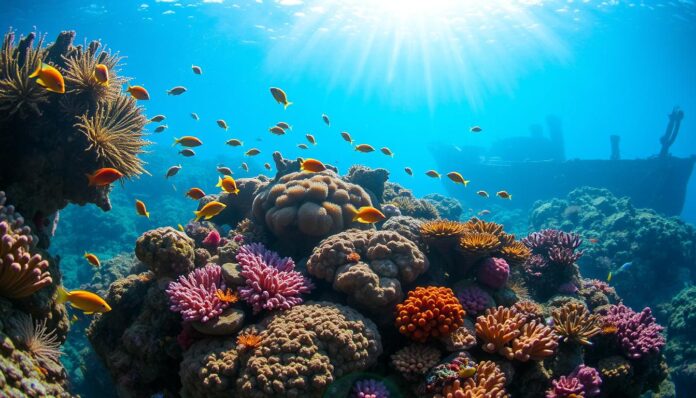| Best Time to Travel | December to May |
| What to Expect | Warm water, clear visibility, diverse marine life |
| Diving Conditions | Year-round, but best from December to May |
| Marine Life | Rays, turtles, sharks, fish, shipwrecks |
Have you ever wondered where the most breathtaking underwater adventures await in the Caribbean? Puerto Rico is a hidden gem for scuba diving enthusiasts. It offers an unparalleled marine exploration experience that will captivate your imagination.
Scuba diving in Puerto Rico turns ocean exploration into an extraordinary journey. With hundreds of miles of stunning shoreline and over 143 islands, this Caribbean destination provides divers with an incredible playground of marine ecosystems. From the crystal-clear waters of Culebra to the diverse marine life around Vieques, Caribbean Sea diving here promises unforgettable experiences for every skill level.
Puerto Rico’s underwater landscape boasts remarkable diversity. Divers can discover over 50 unique dive sites, explore pristine coral reefs, and encounter an incredible array of marine creatures including nurse sharks, rays, sea turtles, and dolphins. The warm waters and exceptional visibility make this destination a true paradise for underwater adventurers.
Key Takeaways – Scuba Diving in Puerto Rico
- Puerto Rico offers over 50 world-class dive sites
- Water temperatures range from 74-85 degrees Fahrenheit year-round
- Visibility can reach up to 150 feet in some locations
- Suitable for divers of all experience levels
- Unique marine ecosystems with diverse wildlife
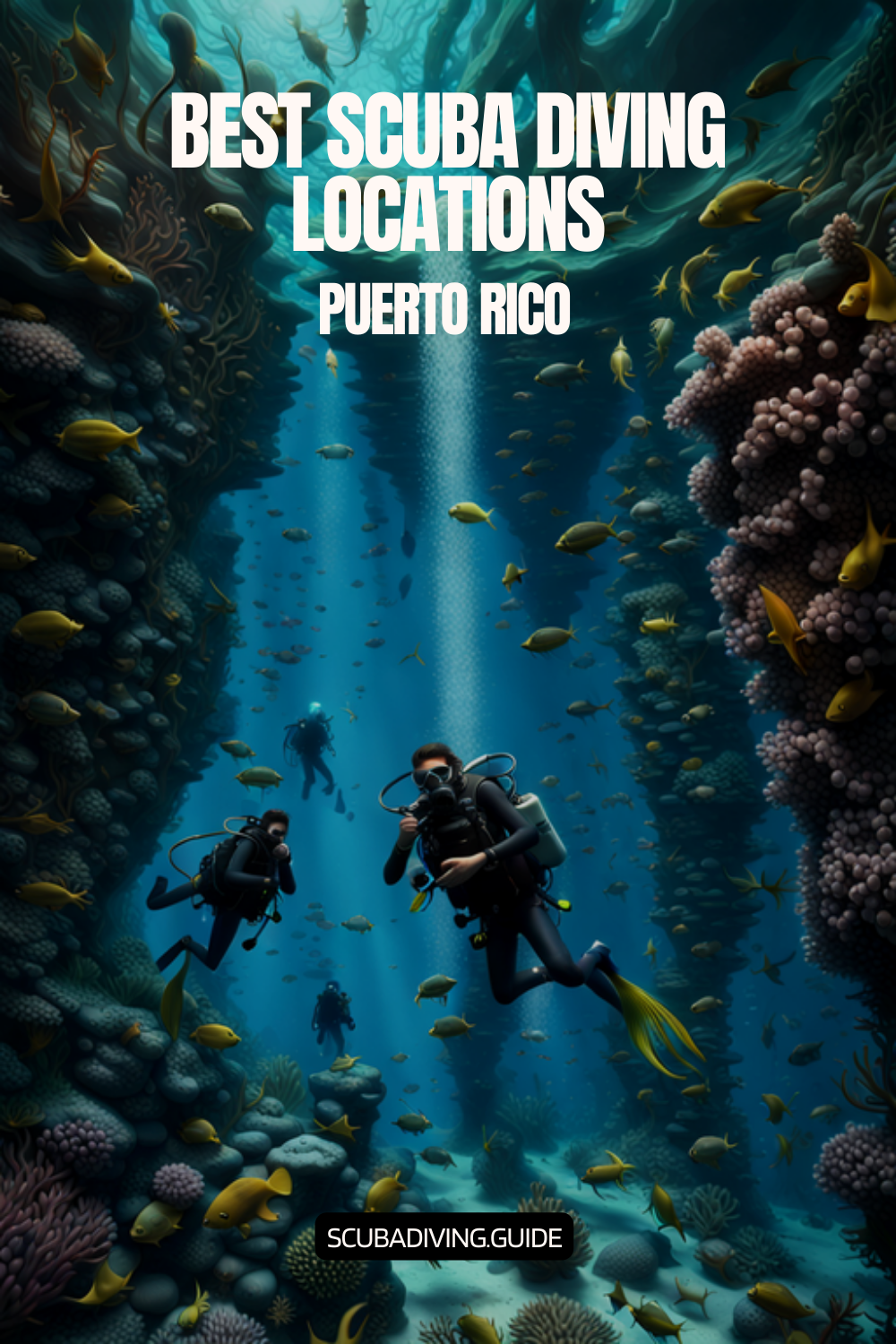
Why Choose Puerto Rico for Scuba Diving?
Puerto Rico is a top spot for scuba diving in the Caribbean. Its clear waters and rich marine life make it a must-visit for divers. The island offers an unforgettable underwater adventure that draws divers from everywhere.
Unique Marine Life
The waters around Puerto Rico are home to a wide variety of marine life. Divers can see colorful coral reefs, exotic fish, and sea turtles. The Caribbean Sea’s rich biodiversity makes it a living underwater world that amazes both new and seasoned divers.
- Over 300 miles of coastline with diverse marine habitats
- Rich coral reef ecosystems
- Abundant tropical fish species
- Potential encounters with sea turtles and marine mammals
Diverse Dive Sites
Puerto Rico has a wide range of dive sites for all levels. From shallow reefs to deep underwater drop-offs, there are over 20 unique dive spots. These sites are spread across the island’s coastlines.
“Puerto Rico’s underwater landscapes are like nature’s own adventure playground for divers.” – Marine Exploration Magazine
Year-Round Diving Conditions
The island’s tropical weather means perfect diving all year. Water temperatures are around 80°F (27°C), and visibility is 60 to 100 feet. This makes Puerto Rico a top choice for scuba diving.
| Diving Attribute | Details |
|---|---|
| Average Water Temperature | 80°F (27°C) |
| Underwater Visibility | 60-100 feet |
| Number of Dive Sites | 20+ distinct locations |
| Dive Shops Available | 50 professional operators |
Whether you’re new to diving or have years of experience, Puerto Rico has an underwater world to explore.
Best Scuba Diving Locations in Puerto Rico
Puerto Rico is a paradise for scuba diving lovers. It has hundreds of miles of coastline and many dive sites. The island’s marine landscape is diverse, attracting divers from everywhere. You can see vibrant coral reefs and unique marine ecosystems, making your dives unforgettable.
Exploring Fajardo’s Underwater Treasures
Fajardo is a top spot for diving in Puerto Rico. It’s known for its rich marine life and stunning coral formations. There are many dive spots here, each with its own depth and marine life.
- Multiple dive sites with depths ranging from 20 to 100 feet
- Rich marine ecosystem with diverse coral formations
- Excellent visibility averaging 60-80 feet
Vieques Island Diving: A Hidden Gem
Vieques Island offers a special diving experience for all. The southern shore has over a dozen dive sites. Depths range from 40 to 100 feet, perfect for both new and seasoned divers.
| Dive Site | Depth Range | Marine Life |
|---|---|---|
| Mosquito Pier | 40 feet | Nurse sharks, rays, turtles |
| Southern Shore Sites | 40-100 feet | Dolphins, lobsters, manatees |
Rincon: Wall Diving Paradise
Rincon is famous for its wall diving near Desecheo Island, just 12 miles away. You can dive through well-preserved coral reefs. Here, you’ll see a variety of marine life in a protected area.
“Rincon’s dive sites provide an unparalleled underwater journey through pristine Caribbean ecosystems.” – Local Diving Expert
Each spot in Puerto Rico has its own charm. Whether you’re a beginner or an experienced diver, there’s a perfect dive for you. Puerto Rico’s marine wonderland awaits your exploration.
Scuba Diving Certification in Puerto Rico
Starting a Diving Certification in Puerto Rico opens a world of underwater adventure. The island has top scuba diving certification programs for all levels. Whether you’re a beginner or an advanced diver, there’s something for you.
Certification Agencies Overview
Puerto Rico is home to top diving certification agencies. PADI (Professional Association of Diving Instructors) is the leading organization. Many dive centers offer PADI certification programs.
- Sea Ventures Pro Dive Center – A 5-star PADI member
- Culebra Divers – The only PADI 5-star Dive Center in Culebra
- Multiple certified training locations across Puerto Rico
Choosing the Right Course
Puerto Rico offers various diving certification courses. Each course is designed for different experience levels:
- Open Water Certification
- 4 days of diving
- Minimum age: 12 years old
- Cost varies by location
- Advanced Open Water
- 6 dives over 2 days
- Recommended for experienced divers
- Specialty Certifications
- Individual pricing
- Various underwater specialties available
Prerequisites for Certification
Before starting your certification, consider these requirements:
- Minimum height: 5’0″ (152 cm)
- Minimum weight: 99 lbs (45 kg)
- Medical fitness assessment
- Swimming proficiency
“Diving is not just a sport, it’s an adventure that reveals the hidden wonders of our planet.” – Professional Diving Instructor
Divers get extra benefits like up to $25,000 free coverage through the Divers Alert Network (DAN). This is valid for 180 days after enrollment. With expert instructors and amazing dive sites, Puerto Rico is the best place for diving certification.
Equipment Rental and Purchase Options
Getting ready for underwater adventures in Puerto Rico means thinking about your diving gear. Whether you’re new to diving or have lots of experience, knowing what gear to choose is important. It makes your diving trips in Puerto Rico fun and easy.
Best Shops for Rental Gear
Puerto Rico has many dive shops with great rental options. You can find top-notch equipment at good prices. This makes diving adventures open to everyone.
- Full equipment sets available from $40-$50 per day
- Individual gear rentals starting at $10-$15
- Variety of sizes from XS to 3XL for most equipment
Equipment Purchase Recommendations
When buying diving gear, focus on what’s essential. Look for items that make you comfortable and safe underwater.
| Equipment | Rental Price | Recommended for Purchase |
|---|---|---|
| Mask | $11 | High priority for personal fit |
| Fins | $11 | Comfort and personal preference |
| BCD | $15 | Consider after multiple dive trips |
Tips for First-Time Renters
If you’re new to diving in Puerto Rico, here are some key rental tips:
- Always inspect equipment before rental
- Verify proper sizing and fit
- Ask about maintenance and cleaning procedures
- Request a demonstration of equipment use
“Renting quality equipment is key to a safe and enjoyable diving experience in Puerto Rico’s beautiful waters.”
Pro tip: Many dive shops offer package deals that can save you money on multiple equipment rentals.
Dive Charters and Tours
Exploring the vibrant Caribbean Sea Diving scene in Puerto Rico requires choosing the right dive charter. Puerto Rico Dive Sites offer incredible underwater experiences for divers of all skill levels.
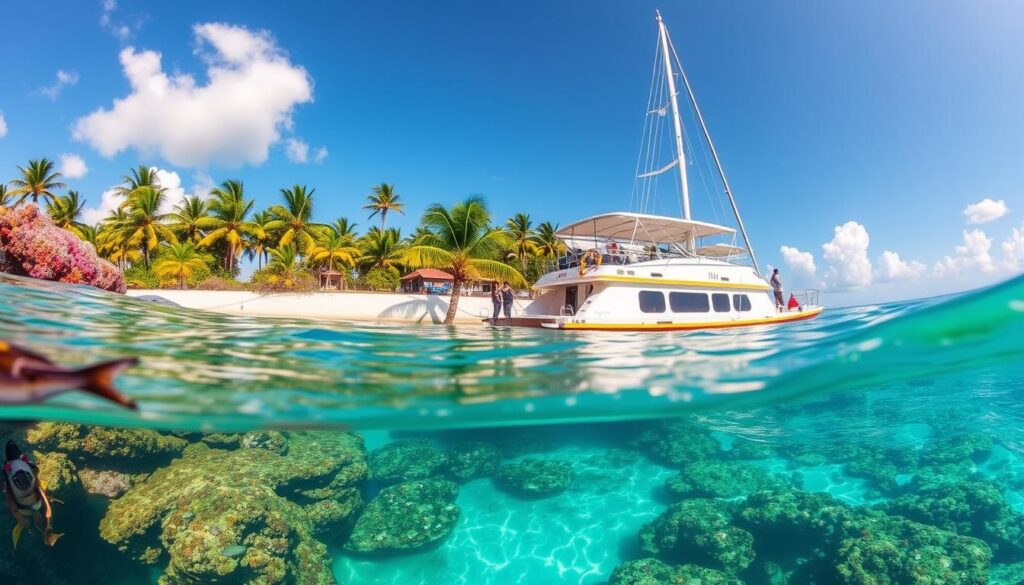
Diving enthusiasts can pick from various charter options for unforgettable underwater adventures. Puerto Rico’s diverse marine landscape has something for every underwater explorer.
Top Recommended Operators
Several standout operators offer exceptional dive experiences:
- Simpatico Charters: Known for personalized experiences
- Aquatica Underwater Adventures: Established in 1986
- West Divers: Specializing in unique dive locations
Group vs. Private Charters
Choosing a charter depends on your preferences and budget. Here’s a quick comparison:
| Charter Type | Price Range | Group Size |
|---|---|---|
| Group Charter | $105-$140 | Up to 7 participants |
| Private Charter | $799-$1,049 | Up to 6 passengers |
What to Expect on a Tour
Most Caribbean Sea Diving tours in Puerto Rico include:
- Professional PADI instructor guidance
- High-quality diving gear
- Underwater video documentation
- Exploration of reefs from 30-85 feet deep
“The underwater world of Puerto Rico offers an experience like no other!” – Experienced Diver
Dive trips last between 1.5 to 6 hours. This gives plenty of time to explore Puerto Rico Dive Sites and see fascinating marine life.
Understanding Puerto Rico’s Marine Ecosystems
Puerto Rico has an amazing underwater world that attracts scuba lovers and marine enthusiasts. The Caribbean waters around it are full of life. This makes diving in Puerto Rico a unique experience.
Exploring Puerto Rico’s underwater world is breathtaking. The island’s waters are home to many marine creatures. It’s a top spot for seeing Puerto Rico’s marine life.
Coral Reefs: Living Underwater Metropolises
Coral reefs in Puerto Rico are like underwater cities. They are full of life and support many marine species. Some key highlights include:
- Tres Palmas Marine Reserve hosts all seven endangered Caribbean coral species
- Coral structures comprise hundreds of tiny polyps
- Unique reef formations provide shelter for diverse marine inhabitants
Shipwrecks: Underwater Historical Treasures
Shipwrecks in Puerto Rican waters are like underwater museums. The B-29 Bomber Wreck is a great example. It has turned into a thriving marine ecosystem.
Diverse Caribbean Fish Species
The waters around Puerto Rico are full of marine life. Divers can see many fish, including:
- Stoplight parrotfish
- Butterfly fish
- Queen angelfish
- Juvenile snappers
- Seahorses
*”The ocean is a vast, mysterious world waiting to be explored,”* – Marine Biologist
Reef diving in Puerto Rico is more than fun. It’s a journey into a complex and beautiful marine world. It inspires and amazes explorers from all over.
Safety Tips for Scuba Divers
Scuba diving in Puerto Rico is an amazing adventure. But, safety is always the top priority. Knowing and following important safety rules can make your dive safe and fun.
Pre-Dive Safety Checks
Before diving into Puerto Rico’s waters, do these safety checks:
- Check all your diving gear carefully
- Make sure your air tank is full and works right
- Test your mask, regulator, and buoyancy control
- Make sure you can signal to your buddy
Recognizing Underwater Hazards
Exploring Puerto Rico’s underwater world means knowing about dangers:
| Hazard Type | Recommended Action |
|---|---|
| Strong Currents | Watch the water, stay with your dive guide |
| Marine Life | Keep 4 feet away from sea creatures |
| Coral Reefs | Don’t touch or harm the reefs |
Emergency Procedures
Being ready for emergencies is important. Here are key steps:
- Stay calm and breathe slowly
- Signal to your buddy for help
- Rise slowly to avoid sickness
- Use emergency devices if you have them
“Safety doesn’t happen by accident. It requires constant vigilance and preparation.” – Diving Safety Expert
Remember, diving safely protects you and Puerto Rico’s ocean.
Marine Conservation Efforts in Puerto Rico
Puerto Rico’s marine ecosystems are vibrant and delicate. They need our protection. Reef diving in Puerto Rico is more than an adventure. It’s a chance to see and support important marine conservation efforts.
The Caribbean waters around Puerto Rico are home to about 800 fish species. Marine protected areas are key to keeping these underwater worlds safe.
Importance of Marine Reserves
Places like Desecheo National Wildlife Refuge are vital for marine life in Puerto Rico. These areas offer many benefits:
- They help keep coral reefs healthy
- They protect endangered sea creatures
- They help keep fish populations balanced
- They provide places for scientists to study and monitor
How Divers Can Help
Responsible divers can make a big difference in marine conservation. Here are some ways to help:
- Join reef monitoring programs
- Follow safe diving practices
- Report any coral diseases you see
- Support local conservation efforts
“Every dive is an opportunity to protect and preserve our marine ecosystems.” – Marine Conservation Expert
Local Organizations to Support
Many organizations are working hard to protect Puerto Rico’s marine environments:
- Oceanic Society (founded in 1969)
- Tres Palmas Marine Reserve
- Local marine research centers
They aim to protect 30% of territorial waters by 2030. Every bit of help counts in protecting these amazing marine ecosystems.
Preparing for Your Diving Trip
Scuba diving in Puerto Rico needs careful planning for a great Caribbean Sea diving experience. Start with the basics: travel documents, gear, and where to stay.
Necessary Travel Documents
Good news for U.S. travelers! If you’re a U.S. citizen, you don’t need a passport for diving in Puerto Rico. Just bring your standard government ID.
- Valid government photo ID
- Driver’s license
- Birth certificate (recommended as backup)
Packing Essentials for Divers
For a successful dive, you need the right gear and clothes. Here’s what to pack:
| Diving Gear | Personal Items |
|---|---|
| Wetsuit | Sunscreen |
| Mask and snorkel | Quick-dry towels |
| Dive computer | Waterproof camera |
| Underwater flashlight | First aid kit |
Accommodations Near Dive Sites
Choose your stay wisely to enhance your diving. La Parguera is close to top dive spots. You’ll find everything from affordable to luxury stays.
“Location is everything when planning your underwater adventure!” – Local Dive Instructor
Pro tip: Stay near great diving spots like Vieques, Culebra, and Fajardo’s Keys. It makes getting to the sea easier.
What to Expect on Your First Dive
Diving in Puerto Rico is thrilling for beginners. The island’s underwater sites are perfect for first-timers to explore. You’ll discover a magical world beneath the waves.
Getting ready for your first dive is important. It makes you feel safe and confident. Dive instructors are there to make sure you have a great time.
Briefing and Onboarding Process
You’ll get a detailed briefing before diving. It covers safety and how to dive. You’ll learn about:
- Equipment familiarization
- Basic safety procedures
- Underwater hand signals
- Emergency response techniques
Basic Diving Skills to Practice
Learning basic diving skills is key. You’ll need to know how to:
- Breathe properly underwater
- Clear your mask
- Control your buoyancy
- Equalize pressure
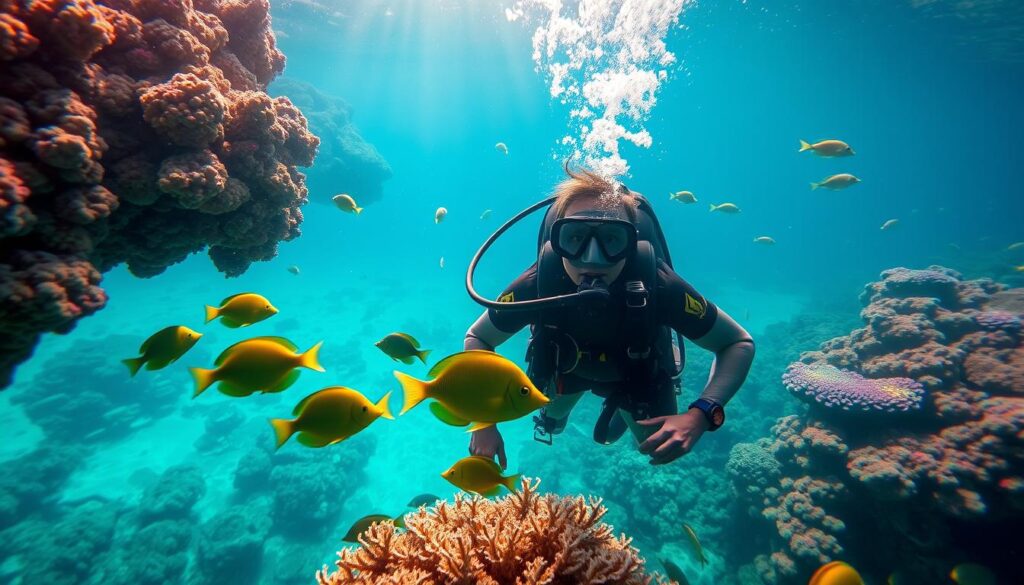
Communication Underwater
Being able to communicate underwater is important. Divers use hand signals to say things like:
| Signal | Meaning |
|---|---|
| Thumbs Up | End of dive/Return to surface |
| Okay Sign | Everything is fine |
| Thumb and Forefinger Together | Low on air |
“The ocean stirs the heart, inspires the imagination and brings eternal joy to the soul.” – Robert Wyland
Your first dive is about having fun and learning. With the right guidance, you’ll soon love exploring Puerto Rico’s underwater world.
Scuba Diving Regulations in Puerto Rico
Scuba diving in Puerto Rico has its own set of rules. The island boasts 108 dive sites, each with its own beauty. But, divers must follow the rules to protect the sea and dive safely.
Legal Dive Depths and Restrictions
Dive sites in Puerto Rico have depth limits based on your certification. Recreational divers face these limits:
- Open Water Certification: Maximum 60 feet
- Advanced Open Water: Up to 130 feet
- Technical Diving: Beyond 130 feet with specialized training
Protected Species and Marine Areas
Some marine areas need extra care from divers. Desecheo Island is one such place, closed to protect its ecosystem. Key areas to watch include:
- Tres Palmas Marine Reserve
- La Parguera Natural Reserve
- Culebra National Wildlife Refuge
Permits and Diving Fees
| Permit Type | Cost | Duration |
|---|---|---|
| Individual Diving Permit | $25 | One Week |
| Annual Marine Conservation Pass | $100 | One Year |
| Group Tour Permit | $50 | Per Expedition |
“Respect the ocean, follow regulations, and enjoy Puerto Rico’s underwater wonders responsibly.”
Divers need permits from the Department of Natural and Environmental Resources (DNER) before diving. Following these rules helps keep Puerto Rico’s sea life safe and ensures diving is sustainable.
Health Considerations for Scuba Diving
Getting a Diving Certification in Puerto Rico means you must focus on your health and safety. If you love diving in the Caribbean Sea, knowing about medical issues is key.
Medical History Screening
It’s important to know your medical history before diving. Some health conditions might need extra checks:
- Chronic ear infections
- Asthma
- Diabetes
- Heart disease
- Lung problems
- Epilepsy
- Fainting episodes
“Safety starts with knowing your body’s limitations”
Decompression Sickness Awareness
Divers need to be aware of decompression sickness (DCS) risks. The Divers Alert Network has rules to help avoid health problems:
- Minimum 12 hours between a single dive and flying
- 18-24 hours between multiple dives and flying
- 24-48 hour surface interval for extended dive series
Hydration and Nutrition Tips
In Puerto Rico’s warm weather, staying hydrated and well-nourished is vital. Drink lots of water, eat healthy meals, and skip alcohol before diving. This keeps you in top shape.
Always talk to a doctor and fill out a detailed medical form before your Diving Certification in Puerto Rico. Your health and safety are the most important things for enjoying the Caribbean Sea’s beauty.
Night Diving Adventures
Puerto Rico Underwater Exploration turns magical at sunset. Night diving shows a new side of the sea, with wonders hidden in daylight.
Unique Experiences of Night Diving
Diving at night reveals a stunning underwater world. Puerto Rico Dive Sites come alive with creatures that hide during the day. You might see:
- Bioluminescent plankton lighting up the sea
- Octopuses hunting for food
- Nurse sharks roaming the reef
- Lobsters and crabs moving around
Safety Precautions for Night Diving
Night diving needs careful planning and attention. Important safety tips include:
- Must-have gear:
- A strong underwater light
- A backup light
- Reflective diving clothes
- Stay close to your dive buddy
- Listen to your instructor
Recommended Night Dive Locations
Puerto Rico has amazing night diving spots:
| Location | Unique Features | Difficulty Level |
|---|---|---|
| Vieques Bioluminescent Bay | UNESCO World Heritage Site with glowing plankton | Beginner |
| La Parguera | Diverse marine ecosystem | Intermediate |
| Culebra Island | Rich coral formations | Advanced |
“Night diving is like entering another world – mysterious, silent, and incredibly beautiful.” – Professional Dive Instructor
Night diving costs $129 per person, available Friday to Monday. You must be 10 or older and have an Advanced Diver certification. Get ready for an unforgettable dive into Puerto Rico’s secrets at night.
Photography Tips for Underwater Shots
Capturing the vibrant Puerto Rico Marine Life needs special skills and gear. Underwater photography turns your Puerto Rico Underwater Exploration into lasting memories. It lets you keep the magical moments beneath the waves.
Selecting the Right Camera for Diving
Finding the perfect underwater camera is tough. Experts suggest several options:
- Compact point-and-shoot cameras with underwater housing
- Mirrorless cameras with dedicated waterproof cases
- Professional DSLR cameras with specialized marine enclosures
Techniques for Marine Life Photography
Catching marine creatures needs special techniques. Here are some tips from pros:
- Use natural light when possible
- Get close to your subject without disturbing it
- Maintain steady positioning
- Practice patience and anticipation
Lens and Equipment Recommendations
| Photography Lens | Recommended Use |
|---|---|
| 60mm Macro Lens | Small marine creatures |
| 100mm Macro Lens | Detailed marine life shots |
| Fisheye Wide-Angle Lens | Large marine environments |
Post-Processing Your Underwater Images
Editing underwater photos needs special skills. Color correction and contrast adjustment are key. They help show the true beauty of Puerto Rico’s marine landscapes.
“Underwater photography is not just about capturing an image, but telling the story of the hidden marine world.” – Marine Photography Expert
With practice and the right gear, you’ll turn your diving trips into stunning visual stories of Puerto Rico’s underwater world.
Future of Scuba Diving in Puerto Rico
Scuba diving in Puerto Rico is getting more exciting. The focus is now on sustainable tourism and new ways to explore underwater. Divers can look forward to new experiences that mix technology with caring for the ocean.
Trends in Eco-Tourism
Protecting the sea is a big deal for divers in Puerto Rico. Local guides are creating tours that are good for the planet. These tours teach people about the importance of keeping the ocean healthy.
Impact of Climate Change on Dive Sites
Climate change is a big problem for Puerto Rico’s seas. Places like Angel Reef and Tres Palmas Marine Reserve are changing. Experts are working hard to keep these places safe for future generations.
Innovations in Scuba Equipment
New technology is changing how we dive. Companies like Underwater Kinetics are making better gear. This gear is safer, lets you see more, and is better for the ocean. It makes diving in Puerto Rico better for everyone.
Puerto Rico Recommended Scuba Diving Itinerary
When planning your scuba diving adventure in Puerto Rico, it’s essential to create an itinerary that allows you to explore the best dive sites and experience the diverse underwater landscapes the island has to offer. Here’s a recommended scuba diving itinerary that combines some of the most popular and captivating dive locations in Puerto Rico:
Day 1: San Juan and Isla de Cabras
Start your diving journey in the vibrant capital city of San Juan. After arriving and settling into your accommodations, head to Isla de Cabras, a short distance from the city. This dive site is known for its underwater rock formations and diverse marine ecosystem. Dive among colorful coral reefs and encounter schools of tropical fish, as you begin to immerse yourself in Puerto Rico’s underwater beauty.
Day 2: Culebra
Take a ferry or a short flight to the stunning island of Culebra, known for its pristine waters and vibrant coral reefs. Dive sites like Carlos Rosario Beach and the Tamarindo Wall offer breathtaking underwater scenery with a wide variety of marine life. Spend the day exploring the depths of Culebra’s dive sites and experiencing the tranquil beauty of this hidden gem.
Day 3: Vieques
Continue your adventure by traveling to the nearby island of Vieques. Dive into the famous Mosquito Pier, a must-visit location known for its spectacular night dives. Witness the mesmerizing display of marine creatures attracted by the pier’s lights, including squids, lobsters, and an array of colorful fish. During the day, explore other dive sites around Vieques, each offering its unique underwater wonders.
Day 4: Mona Island
Embark on a thrilling excursion to Mona Island, located off the west coast of Puerto Rico. This protected nature reserve is a paradise for advanced divers. Dive into its pristine waters, where you’ll encounter dramatic drop-offs, underwater caves, and an abundance of marine life, including sea turtles, reef fish, and the occasional sighting of dolphins and whales. The untouched beauty of Mona Island promises an unforgettable diving experience.
Day 5: La Parguera Bioluminescent Bay
Take a break from traditional scuba diving and experience the magical phenomenon of bioluminescence. Visit La Parguera, a coastal town renowned for its bioluminescent bay. Take a night dive or snorkeling excursion to witness the stunning glow of the water caused by microscopic organisms. This unique and enchanting experience will leave you in awe of Puerto Rico’s natural wonders.
Day 6: Desecheo Island
Travel west to Desecheo Island, another renowned dive spot in Puerto Rico. This remote island offers crystal-clear waters and healthy coral reefs teeming with marine life. Dive along dramatic walls, where you can encounter large pelagic species such as sharks, rays, and schools of barracudas. The vibrant underwater world of Desecheo Island will captivate your senses.
Day 7: Rincon and Tres Palmas Marine Reserve
End your scuba diving journey in Rincon, a town famous for its surfing spots and beautiful coastline. Explore the Tres Palmas Marine Reserve, a haven for marine enthusiasts. Snorkel or dive in its clear waters, marvel at the healthy coral reefs, and keep an eye out for humpback whales during their migration season. Wrap up your diving itinerary with unforgettable encounters in this underwater paradise.
This recommended scuba diving itinerary in Puerto Rico offers a diverse range of dive sites, each with its unique characteristics and marine life. From the historical sites of Isla de Cabras to the pristine beauty of Mona Island and the vibrant underwater landscapes of Culebra and Vieques, you’ll experience the best that Puerto Rico has to offer beneath the waves. Prepare to be amazed as you explore these captivating dive destinations and create memories that will last a lifetime.
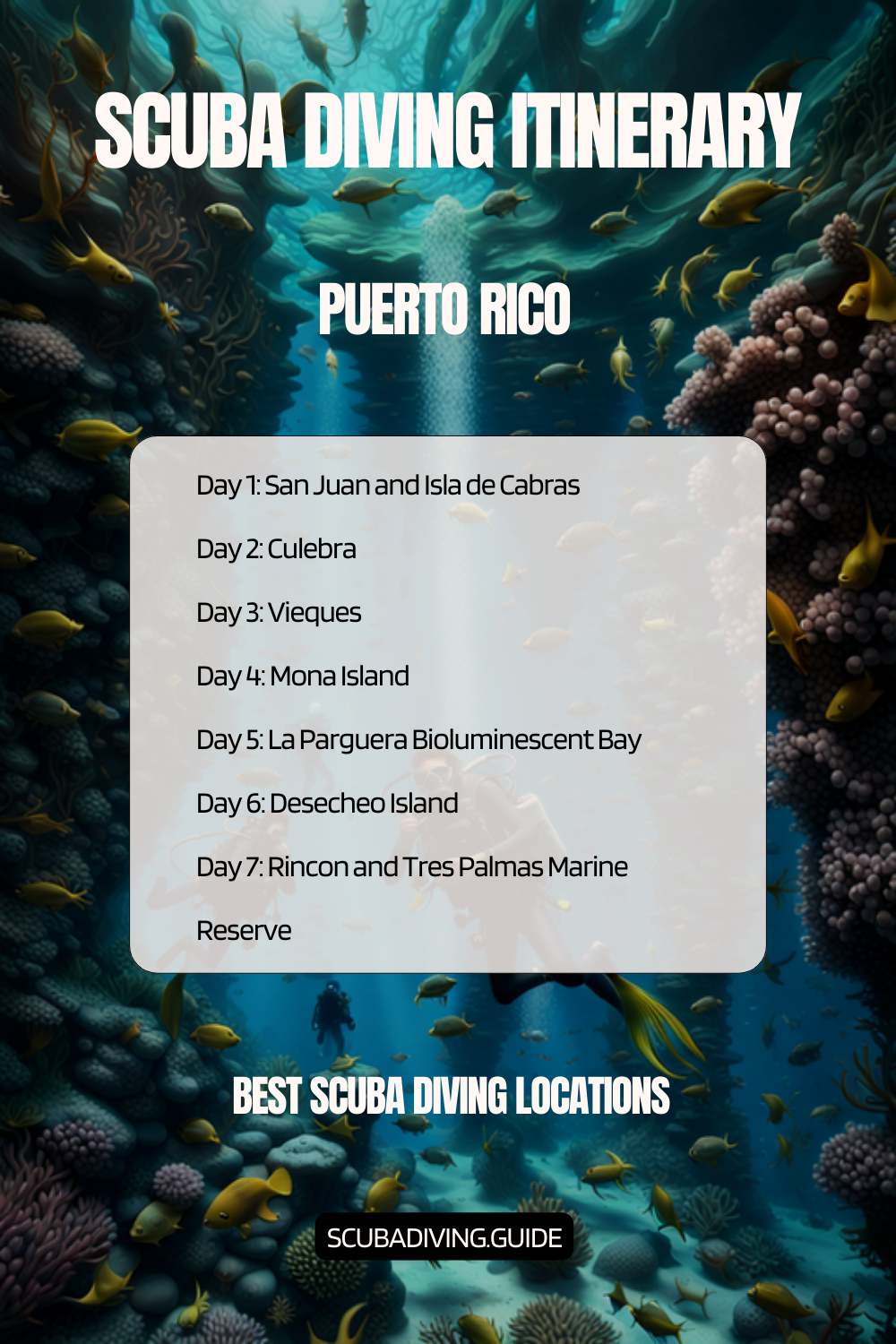
Other Countries to Consider
- Anguilla
- Antigua and Barbuda
- Aruba
- Bahamas
- Barbados
- Bonaire
- British Virgin Islands
- Cayman Islands
- Cuba
- Curaçao
- Dominica
- Dominican Republic
- Grenada
- Guadeloupe Islands
- Haiti
- Jamaica
- Martinique
- Montserrat
- Saba
- Saint Barthélemy
- Saint Kitts & Nevis
- Saint Lucia
- Saint Vincent and the Grenadines
- Sint Eustatius
- Sint Maarten
- The Turks And Caicos Islands
- Trinidad and Tobago
- United States Virgin Islands
FAQ – Scuba Diving in Puerto Rico
Do I need a certification to scuba dive in Puerto Rico?
Yes, most dive operators require Open Water Certification. This is from agencies like PADI or SSI. If you’re not certified, you can take courses in Puerto Rico to get your diving credentials.
What is the best time of year to go scuba diving in Puerto Rico?
Puerto Rico has diving conditions all year. Water temperatures are 78-82°F (26-28°C). The best time is from December to April, when it’s calm and clear.
What marine life can I expect to see while diving in Puerto Rico?
You’ll see colorful fish, sea turtles, rays, and barracudas. Coral species are also common. You might see nurse sharks and humpback whales in certain seasons.
Are there any special diving regulations in Puerto Rico?
Yes, there are rules to protect marine life. Some areas, like Desecheo National Wildlife Refuge, have special rules. Always follow local guidelines and get necessary permits.
How much does scuba diving cost in Puerto Rico?
Prices vary. Introductory dives cost $80-$120. Certified dives are $100-$150. Certification courses are $350-$500, depending on the level and dive shop.
Is Puerto Rico safe for scuba diving?
Puerto Rico is very safe for diving. Dive operators are professional, and equipment is well-maintained. Always follow safety rules and dive within your skill level.
Do I need to bring my own diving equipment?
You can bring your own, but most shops offer rentals. Renting is convenient and cost-effective, perfect for beginners or travelers.
What are the top diving locations in Puerto Rico?
Top spots include Fajardo, Vieques Island, Culebra, and Rincon. Each offers unique dives, from coral reefs to wall dives.
Are there night diving opportunities in Puerto Rico?
Yes! Puerto Rico has amazing night dives, like Vieques’ Bioluminescent Bay. Night dives let you see nocturnal life and bioluminescent phenomena.
What health considerations should I keep in mind for diving?
Get a medical clearance and be in good shape before diving. Stay hydrated, avoid alcohol, and know about risks like decompression sickness. Dive operators will ask for a health questionnaire.
